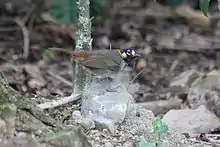White-eared ground sparrow
The white-eared ground sparrow (Melozone leucotis) is a large American sparrow which breeds in a small range of Central America at middle altitudes from southern Mexico and Guatemala to northern Costa Rica. The species range is on the Pacific side of Central America, and Belize (on the Gulf of Mexico) and Honduras are not in its normal range.
| White-eared ground sparrow | |
|---|---|
 | |
| Scientific classification | |
| Kingdom: | Animalia |
| Phylum: | Chordata |
| Class: | Aves |
| Order: | Passeriformes |
| Family: | Passerellidae |
| Genus: | Melozone |
| Species: | M. leucotis |
| Binomial name | |
| Melozone leucotis Cabanis, 1861 | |
 | |
This bird is found typically at altitudes between 500 and 2,000 m (1,600 and 6,600 ft) in the undergrowth and thickets of ravines, forest edge, and other semi-open woodland including second growth and large gardens. The nest, built by the female, is a massive bowl of stems, twigs and other plant material constructed on the ground or less than 75 cm (2.46 ft) up, and hidden amongst banana plants, orchids or similar cover. The female lays two brown-blotched white eggs, which she incubates for 12–14 days. The male helps in feeding the chicks.
The white-eared ground sparrow is on average 17.5 cm (6.9 in) long and weighs 43 g (1.5 oz). The adult has a stubby dark-grey bill and unstreaked olive-brown upperparts. The head is mainly black with a broken white eye ring and white patches in front of and behind the eye. The nape is green and the sides of the neck are bright yellow. The throat and breast patch are black, separated by a thin rufous-grey line, and the rest of the underparts are mainly white with grey on the flanks. Young birds have yellower underparts, and a duller indistinct head pattern.
North Nicaragua birds, M. l. nigrior, have a much broader black breast spot than the nominate Costa Rican form, and the northernmost of the three subspecies, M. l. occipitalis, has a grey crown stripe, obvious yellow supercilium, and very small breast spot.
White-eared ground sparrow calls include a thin tsip. The male's song is an explosive whistled spit-CHUR see-see-see.
The white-eared ground sparrow feeds on the ground on seeds, fallen berries, insects and spiders. It is usually in pairs, and is a shy species best seen at near or dusk, although easier to find than its skulking relative, Prevost's ground sparrow.
References
- BirdLife International (2012). "Melozone leucotis". IUCN Red List of Threatened Species. 2012. Retrieved 7 July 2014.CS1 maint: ref=harv (link)
- Olsson, Urban; Curson, Jon (1995). Buntings and Sparrows - A Guide to the Buntings and North American Sparrows. Illustrated by Clive Byers. Pica Press. ISBN 1-873403-19-4.
- Stiles, F. Gary; Skutch, Alexander F. (1989). A Guide to the Birds of Costa Rica. Comstock Publishing Associates. ISBN 0-8014-9600-4.
External links
| Wikimedia Commons has media related to Melozone leucotis. |
| Wikispecies has information related to Melozone leucotis. |
- "White-eared ground sparrow media". Internet Bird Collection.
- Stamp (for El Salvador) at bird-stamps.org
- Pájaros de Costa Rica [Birds of Costa Rica] (in Spanish)
- White-eared ground sparrow photo gallery at VIREO (Drexel University)
- White-eared ground sparrow species account at Neotropical Birds (Cornell Lab of Ornithology)
- Interactive range map of Melozone leucotis at IUCN Red List maps
